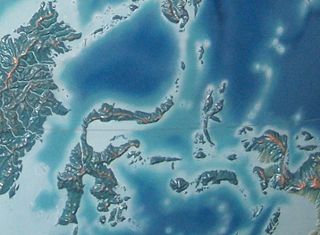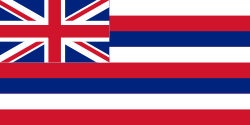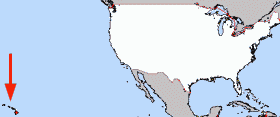Difference between revisions of "Maluku Islands" - New World Encyclopedia
Mike Butler (talk | contribs) m |
Mike Butler (talk | contribs) (Maluku Islands - info box) |
||
| Line 1: | Line 1: | ||
| + | {| border=1 align=right cellpadding=2 cellspacing=0 width=300 style="margin: 0.5em 0 1em 1em; background: #ffffff; border: 1px #aaaaaa solid; border-collapse: collapse; font-size: 95%;" | ||
| + | |+<big><big>'''Hawaii'''</big></big> | ||
| + | |- | ||
| + | | style="background:#ffffff;" align=center colspan=2 | | ||
| + | {| border=0 cellpadding=2 cellspacing=0 | ||
| + | | align=center width=296 | [[Image:Flag of Hawaii.svg |250px|Flag of Hawaii]] | ||
| + | |- | ||
| + | | align=center width=296 | [[Flag of Hawaii]] | ||
| + | |} | ||
| + | |- | ||
| + | | align=center colspan=2 | [[Image:LocationHawaii.png]] | ||
| + | |- | ||
| + | | '''Official languages''' | ||
| + | | Hawaiian English, Hawaiian | ||
| + | |- | ||
| + | | '''Capital''' | ||
| + | | Honolulu | ||
| + | |- | ||
| + | | '''Governor''' | ||
| + | | Linda Lingle (R) | ||
| + | |- | ||
| + | | '''Senators''' | ||
| + | | Daniel Inouye (D)<br />Daniel Akaka (D) | ||
| + | |- | ||
| + | | '''Representatives''' | ||
| + | | Neil Abercrombie (D)| Ed Case (D) (D) | ||
| + | |- | ||
| + | | '''Area''' | ||
| + | Ranked 43rd<br/> – Total<br/> – % water | ||
| + | | <br/> 16,636km²<br/> 0 | ||
| + | |- | ||
| + | | '''Population''' | ||
| + | Ranked 42nd<br/> – Total (2000) | ||
| + | | <br /> 1,211,537 | ||
| + | |- | ||
| + | | '''Currency''' | ||
| + | | U.S. dollar | ||
| + | |- | ||
| + | | '''Time zone''' | ||
| + | | Universal Time-10<br/>(no daylight saving time) | ||
| + | |- | ||
| + | | '''National anthem''' | ||
| + | | Star-Spangled Banner | ||
| + | |- | ||
| + | | '''Calling Code''' | ||
| + | |1 | ||
| + | |- | ||
| + | | '''Internet TLD''' | ||
| + | | .us | ||
| + | |} | ||
| + | |||
:''This page is about the geography and history of the island group in [[Indonesia]] — for the political entities encompassing the islands, see [[Maluku (Indonesian province)]] and [[North Maluku]].'' | :''This page is about the geography and history of the island group in [[Indonesia]] — for the political entities encompassing the islands, see [[Maluku (Indonesian province)]] and [[North Maluku]].'' | ||
The '''Maluku Islands''' (also known as the '''Moluccas''', '''Moluccan Islands''' or simply '''Maluku''') are an [[archipelago]] in [[Indonesia]], and part of the larger [[Malay Archipelago]]. They are located on the [[Australian Plate]], lying east of [[Sulawesi]] (Celebes), west of [[New Guinea]], and north of [[Timor]]. The [[island]]s were also historically known as the "[[Spice Islands]]" by the [[China|Chinese]] and [[European]]s, but this term has also been applied to other islands. | The '''Maluku Islands''' (also known as the '''Moluccas''', '''Moluccan Islands''' or simply '''Maluku''') are an [[archipelago]] in [[Indonesia]], and part of the larger [[Malay Archipelago]]. They are located on the [[Australian Plate]], lying east of [[Sulawesi]] (Celebes), west of [[New Guinea]], and north of [[Timor]]. The [[island]]s were also historically known as the "[[Spice Islands]]" by the [[China|Chinese]] and [[European]]s, but this term has also been applied to other islands. | ||
Revision as of 23:21, 23 September 2006
- This page is about the geography and history of the island group in Indonesia — for the political entities encompassing the islands, see Maluku (Indonesian province) and North Maluku.
The Maluku Islands (also known as the Moluccas, Moluccan Islands or simply Maluku) are an archipelago in Indonesia, and part of the larger Malay Archipelago. They are located on the Australian Plate, lying east of Sulawesi (Celebes), west of New Guinea, and north of Timor. The islands were also historically known as the "Spice Islands" by the Chinese and Europeans, but this term has also been applied to other islands.
Most of the islands are mountainous, some with active volcanoes, and enjoy a wet climate. The vegetation of the small and narrow islands, encompassed by the sea, is very luxuriant; including rainforests, sago, rice, and the famous spices—nutmeg, cloves and mace (spice), among others. Though originally Melanesian, many island populations, especially in the Banda Islands, were decimated in the 17th century. A second influx of Malay immigrants began in the early twentieth century under the Dutch and continued in the Indonesian era.
Politically, the Maluku Islands formed a single province of Indonesia from 1950 until 1999. In 1999 the North Maluku (Maluku Utara) and Halmahera Tengah (Central Halmahera) regency were split off as a separate province, so the islands are now divided between two provinces, Maluku and North Maluku. Between 1999 and 2002 they were known for religious conflicts between Muslims and Christians but have been peaceful in the past years.

Prehistoric and colonial history
The people of the Maluku have been sailors and traders for thousands of years. The earliest archaeological evidence of human occupation of the region is about thirty-two thousand years old, but evidence of even older settlements in Australia may mean that Maluku had earlier visitors. Evidence of increasingly long-distance trading relationships and of more frequent occupation of many islands, begins about ten to fifteen thousand years later. Onyx beads and segments of silver plate used as currency on the Indian subcontinent around 200B.C.E. have been unearthed on some of the islands. In addition, local dialects employ derivations of the Malay word then in use for 'silver', in contrast to the term used in wider Melanesian society, which has etymological roots in Chinese, a consequence of the regional trade with China that developed in the 500s and 600s.
Although cultures varied across this dispersed group of islands, there is a sense in which the Moluccas were a cosmopolitan society, in that traders from across the region took residence in Moluccan settlements, or in nearby enclaves, to conduct spice business. Arab and Chinese traders frequently visited or lived in the region.
In 1513 the Portuguese landed on Ambon island, which produced some cloves, but also played an entrepot role in the region. A Portuguese fort and a degree of security followed, helped by a buffer of indigenous Christian converts who were settled about the fort and formed the nucleus of what became Ambon city (the current capital of Maluku province). But the Portuguese presence on Ambon Island was regularly challenged by attacks from indigenous Muslims on the island's northern coast, in particular Hitu, which had trading and religious links with major port cities on Java's north coast. Indeed, the Portuguese never managed to control the local trade in spices, and failed in attempts to establish their authority over the Banda Islands, the nearby centre of nutmeg production. The Spaniards took control of Ternate and Tidore. While Roman Catholicism slowly spread among the native population of Ambon (for a time the missionary Saint Francis Xavier resided in Ambon) most of the region remained Muslim.
The Dutch arrived in 1599 and reported indigenous discontent with Portuguese attempts to monopolise their traditional trade. After the Ambonese helped the Dutch to construct a fort at Hitu Larna, the Portuguese begun a campaign of retribution against which the Ambonese invited Dutch aid. After 1605 Frederik Houtman became the first Dutch governor of Ambon.
The Dutch East-India Company was a company with three obstacles in its way: the Portuguese, controlling the aboriginal populations, and the British. Again smuggling would be the only alternative to a European monopoly. Among other events of the 17th century, the Bandanese attempted independent trade with the British, the East-India Company's response was to decimate the native population of the Banda Islands sending the survivors fleeing to other islands and installing slave labour.
Though other races re-settled the Banda Islands, the rest of Maluka remained uneasy under foreign control and even after the Portuguese had a new trading station at Macassar there were native revolts in 1636 and 1646. Under company control northern Maluka was administered by the Dutch residency of Ternate, and the southern by "Amboyna" (Ambon).
During the Japanese occupation in World War II, the Moluccans fled to the mountains but begun a campaign of resistance also known as the South Moluccan Brigade. After the war's end the island's political leaders had successful discussions with the Netherlands about independence. Complicated by Indonesian demands, the Round Table Conference Agreements were signed in 1949 transferring Maluku to Indonesia with mechanisms for the islands to choose or opt out of the new Indonesia. The Agreements granted Moluccans the right to determine their ultimate sovereignty.
Indonesian history
With the declaration of a unitary republic of Indonesia in 1950 to replace the federal state, the South Moluccas (Maluku Selatan) attempted to secede. This movement was led by Ch. Soumokil (former Supreme Prosecutor of the Eastern Indonesia state) and supported by the Moluccan members of the Netherlands special troops. Lacking support from the locals, this movement was crushed by Indonesian army and by the special agreement with Netherlands the troops were transferred to Netherlands. The commencement of Indonesian transmigration of (mainly) Javanese populations to the outer islands (including Maluku) during the 1960s is thought to have aggravated independence and issues of religious / ethnic politics. There has been intermittent ethnic and nationalist violence on the islands and acts of terrorism by members of the Republik Maluku Selatan (RMS) government-in-exile in the Netherlands since that time.
Maluku is one of the first provinces of Indonesia, proclaimed in 1945 until 1999, when the Maluku Utara and Halmahera Tengah Regencies were split off as a separate province of North Maluku. Its capital is Ternate, on a small island to the west of the large island of Halmahera. The capital of the remaining part of Maluku province remains at Ambon.
The situation in much of Maluku became highly unpredictable when religious-nuance conflict erupted in the province in January 1999. The subsequent 18 months were characterized by fighting between largely local groups of Muslims and Christians, the destruction of thousands of houses, the displacement of approximately 500,000 people, the loss of thousands of lives, and the segregation of Muslims and Christians. The following 12 months saw periodic eruptions of violence, which appeared more targeted and premeditated, designed to keep suspicions high and people segregated. In spite of numerous negotiations and the signing of a peace agreement in February 2002, tensions on Ambon remained high until late 2002, when a series of spontaneous 'mixings' between previously hostile groups led to an increasingly stable peace.
ReferencesISBN links support NWE through referral fees
- Bellwood, Peter (1997). Prehistory of the Indo-Malaysian archipelago. Honolulu: University of Hawai'i Press. ISBN 0-8248-1883-0.
- Andaya, Leonard Y. (1993). The World of Maluku: Eastern Indonesia in the Early Modern Period. Honolulu: University of Hawai'i Press. ISBN 0-8248-1490-8.
- Donkin, R. A. (1997). Between East and West: The Moluccas and the Traffic in Spices Up to the Arrival of Europeans. American Philosophical Society. ISBN 0-87169-248-1.
- Monk, Kathryn A., Yance De Fretes, Gayatri Reksodiharjo-Lilley (1997). The Ecology of Nusa Tenggara and Maluku. Singapore: Periplus Press. ISBN 962-593-076-0.
- Van Oosterzee, Penny (1997). Where Worlds Collide: The Wallace Line. Ithaca: Cornell University Press. ISBN 0-8014-8497-9.
- Wallace, Alfred Russel (2000; originally published 1869). The Malay Archipelago. Singapore: Periplus Press. ISBN 962-593-645-9.
External links
| ||||||||||||||||||||||
| Countries and territories of Oceania | |
| Australia : Australia · Norfolk Island | |
| Melanesia : East Timor · Fiji · Maluku Islands & Western New Guinea (part of Indonesia) · New Caledonia · Papua New Guinea · Solomon Islands · Vanuatu | |
| Micronesia : Guam · Kiribati · Marshall Islands · Northern Mariana Islands · Federated States of Micronesia · Nauru · Palau · Wake Island | |
| Polynesia : American Samoa · Cook Islands · French Polynesia · Hawaii · New Zealand · Niue · Pitcairn Islands · Samoa · Tokelau · Tonga · Tuvalu · Wallis and Futuna | |
| ||||||||||||||||||||||||||||||||||||||||||||||||||||||
ar:جزر الملوك bg:Молукски острови ca:Moluques da:Molukkerne de:Molukken et:Maluku saared es:Molucas fr:Moluques he:איי מלוקו id:Kepulauan Maluku it:Molucche ja:モルッカ諸島 lt:Molukų salos nl:Molukken no:Molukkene pl:Moluki pt:Ilhas Molucas simple:Malaku Islands fi:Molukit sv:Maluku zh:摩鹿加群岛
Credits
New World Encyclopedia writers and editors rewrote and completed the Wikipedia article in accordance with New World Encyclopedia standards. This article abides by terms of the Creative Commons CC-by-sa 3.0 License (CC-by-sa), which may be used and disseminated with proper attribution. Credit is due under the terms of this license that can reference both the New World Encyclopedia contributors and the selfless volunteer contributors of the Wikimedia Foundation. To cite this article click here for a list of acceptable citing formats.The history of earlier contributions by wikipedians is accessible to researchers here:
The history of this article since it was imported to New World Encyclopedia:
Note: Some restrictions may apply to use of individual images which are separately licensed.


